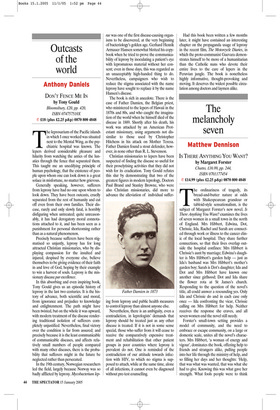The melancholy seven
Matthew Dennison
IS THERE ANYTHING YOU WANT? by Margaret Forster Chatto, £16.99, pp. 244, ISBN 0701177454 ✆ £14.99 (plus £2.25 p&p) 0870 800 4848 The ordinariness of tragedy, its bread-and-butter nature at odds with Shakespearean grandeur or tabloid-style sensationalism, is the subject of Margaret Forster’s new novel. Is There Anything You Want? examines the lives of seven women in a small town in the north of England. Mrs Hibbert, Edwina, Dot, Chrissie, Ida, Rachel and Sarah are connected through work or illness to the cancer clinic of the local hospital. They share further connections, so that their lives overlap outside the hospital confines: Mrs Hibbert is Chrissie’s aunt by marriage; Edwina’s daughter is Mrs Hibbert’s garden help — just as Ida’s husband was Mrs Hibbert’s mother’s garden boy; Sarah is Dot’s daughter; Ida and Dot and Mrs Hibbert have known one another since girlhood; Dot and Ida share the flower rota at St James’s church. Responding to the question of the novel’s title, all could answer a resounding yes. Only Ida and Chrissie do and in each case only once — Ida confronting the vicar, Chrissie calling on Mrs Hibbert for help. Neither receives the response she craves, and all seven women end the novel still needy.
Forster’s small-town setting provides a model of community, and the need to embrace or escape community, on a large or domestic scale, unites all the novel’s characters. Mrs Hibbert, ‘a woman of energy and vigour’, dominates the book, offering help to friends and strangers alike, pulling people into her life through the ministry of help, and so filling her days and her thoughts: ‘Help, that was what was wanted, that was what she had to give. Knowing this was what gave her strength. What fools people were to think they could manage on their own.’ Her intentions are straightforward, uncynical, but it is left to Forster, not Mrs Hibbert, to elucidate the extent to which, for each of the novel’s ‘helpers’, helping others and self-help merge — ‘it was being useful . . . liked, that was what made her happy’. Ultimately this is not enough. Edwina, Chrissie and Ida collapse, crippled by the pressures of their lives. Mrs Hibbert holds on to equivocal contentment by immersion in her voluntary work. ‘Too much was asked of her, everyone wanted something from her and there was no one to listen to what she might want.’ Only Rachel fleetingly escapes, liberated by the exhilaration of glider-flying.
Forster’s characters inhabit a small physical compass, but their interior landscapes range widely. Inevitably, the women are not uniformly rounded. Edwina describes herself as ‘a background person, someone upon whom attention would never focus’; Forster takes to heart this self-assessment and virtually abandons her for the second part of the novel. Unlovely Sarah is hastily sketched. Chrissie finds a resolution to her unhappiness that, though convincing, is predictable. Compared with her fellow players, Rachel is in free fall, hardly connected to the novel’s small town or the six other women. Ida and Dot and especially Mrs Hibbert are the heroines of Is There Anything You Want?, a latterday anatomy of melancholy written with insight, wit and tremendous style.






















































 Previous page
Previous page